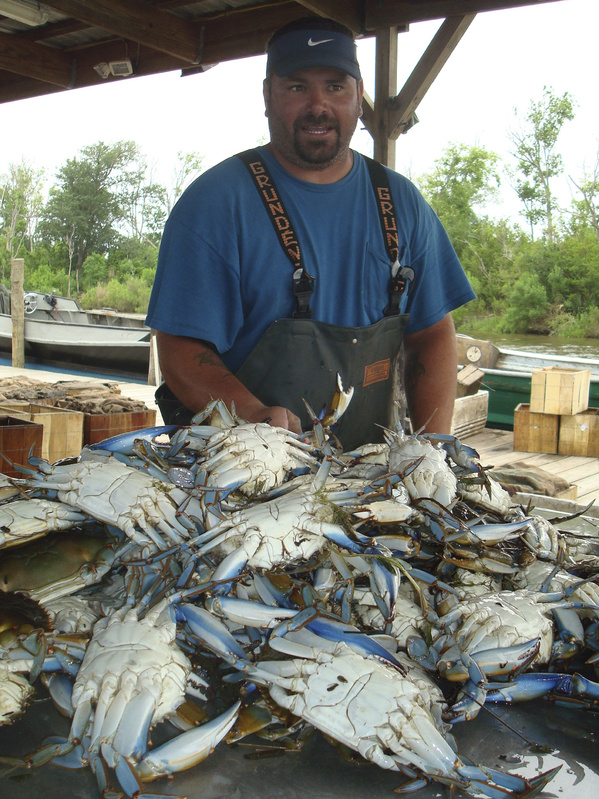HOPEDALE, La. — When Kenny LeFebvre is out of work, so are the two men who help him haul glistening blue crabs from the waters he’s fished since he quit school at 14. So are his sister and brother-in-law, who sell him bait, buy back the catch, pack it up, then resell it to buyers who put it on dinner tables in Maryland.
And so are thousands of other families just like theirs in some of the world’s richest fishing grounds, livelihoods in limbo as winds from exactly the wrong direction – the southeast – threaten to push an oil slick the size of Puerto Rico closer to the fragile bayous.
“I don’t know what I’ll do. I really don’t,” says LeFebvre, who unloaded 2,100 pounds of crab about 20 minutes before natural resource officials ordered the fishing zones in St. Bernard Parish closed. There was no sign of oil yet. Not even a whiff in the breeze. And the crabs had just started biting.
On Sunday, federal authorities banned commercial and recreational fishing over a wide swath of the Gulf of Mexico, from the mouth of the Mississippi to the Florida Panhandle, for at least the next 10 days.
Now, the 600 traps LeFebvre dropped Friday morning will sit uncollected for weeks, he figures. Maybe months. Maybe years.
How he’ll support six children, ages 9 to 18, is beyond his ability to imagine.
“I’m 35. I ain’t never drove a nail in my life. This is what I know, right here,” he says. “We starved all winter, and we was just getting to where we was making money and getting back on our feet.”
More than birds and fish lie in the path of the massive oil slick threatening the Gulf Coast from Florida to Texas: A centuries-old way of life that has endured dozens of hurricanes is now facing the possibility of environmental and economic disaster.
Water sustains the region’s economy like blood in the body. Commercial and sport fishing businesses support dock services, tackle shops and gas stations. Restaurants are Louisiana’s largest private-sector employer, with 140,000 workers and a direct annual economic impact of $5 billion. Wendy Waren, vice president of the Louisiana Restaurant Association, says nearly two-thirds of them serve some type of seafood.
Then there are some of the busiest shipping ports in the world, moving oil from offshore rigs up the Mississippi and Midwestern grain out to sea to feed the rest of the world.
All are vital to world commerce and have a potential impact on consumer pocketbooks.
The Port of Gulfport in Mississippi is the nation’s second-largest importer of green fruit, with Central American bananas from Chiquita and Dole accounting for 74 percent of its imported cargo in 2007.
The Port of New Orleans handled 73 millions tons of cargo in 2008, including coffee from South America and steel from Japan, Russia, Brazil and Mexico. Three cruise ships dock there, handling over 600,000 passengers a year.
Upriver is the Port of South Louisiana, the nation’s busiest with 224 million tons of cargo a year – mostly grain and other agricultural commodities, and chemicals from the scores of plants that line the river.
About 120 miles away in Ocean Springs, Miss., Paul Nettles, 38, worries about losses of his own. He and his partners at South Coast Paddling Co. started their kayaking business last August, taking tourists through inland salt marshes and to some of the barrier islands.
“We just spent all year advertising and marketing, and it’s just now starting to pay off. If the whole summer is a wash, it could be devastating,” says Nettles, preparing to take 12 highway contractors on a tour of Old Fort Bayou.
Recreational fishing draws some 6 million saltwater anglers a year, supports more than 300,000 jobs and contributes $41 billion dollars a year to the Gulf Coast economy, according to the American Sportfishing Association.
Louisiana is America’s top producer of shrimp, oysters, crabs, crawfish and alligators, shipping out 30 percent of all the seafood in the lower 48 states, says Ewell Smith, executive director of the Louisiana Seafood Promotion and Marketing Board. That adds up to an economic impact of $2.4 billion a year.
Louisiana fishermen landed 90.4 million pounds of shrimp in 2008, or 44 percent of U.S. production, and 207 million pounds of oysters, or 36 percent of the U.S. total, Smith says. Any hiccup in production opens the door to foreign competition, which already accounts for 80 percent of the nation’s seafood consumption.
On tiny Grand Isle, which boasts Louisiana’s only white-sand beaches, the manager of the Island Paradise Suites is also fretting about what could happen this summer. Every weekend, says manager Penny Benton, there’s a fishing rodeo that supports the bait shops, eateries and motels.
“My worst fear is nobody wanting to come down because they can’t fish, they can’t shrimp, they can’t do anything,” says Benton, 45, who counts on her job at her aunt’s inn to support her 8- and 12-year-old children. “I don’t even want to think about that. I know I need to, but I don’t want to.”
“We’re just praying. That’s all we can do,” she says. “Everybody’s scared to death.”
Send questions/comments to the editors.



Success. Please wait for the page to reload. If the page does not reload within 5 seconds, please refresh the page.
Enter your email and password to access comments.
Hi, to comment on stories you must . This profile is in addition to your subscription and website login.
Already have a commenting profile? .
Invalid username/password.
Please check your email to confirm and complete your registration.
Only subscribers are eligible to post comments. Please subscribe or login first for digital access. Here’s why.
Use the form below to reset your password. When you've submitted your account email, we will send an email with a reset code.